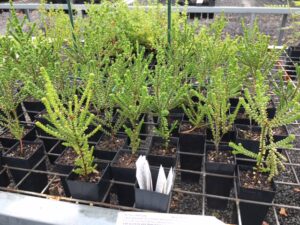We regularly receive emails with queries about Australian native plants. Glenda Browne summarises recent responses on propagation from our experts group.

Propagation calendar
We were asked whether our society has a calendar listing months for propagation of native plants.
The answer is No, but some general advice was provided. Home-scale propagation and nursery-scale propagation vary. Propagation timing depends on factors such as when you get access to cuttings or seeds, when you need the plants, how much space your propagation facilities have and local climate conditions.
Cuttings strike best when taken in late spring to summer, but if you have plants needing pruning at other times of year it is still worth giving it a go.
Seeds are usually best germinated in warmer months but can be done all year if a warm moist frost-free area is available. If you are raising species such as eucalypts, the routine is to raise seedlings during the summer for planting out the following winter. One exception to the summer rule is blackthorn, Bursaria spinosa, which should be sown during winter.
For more information:
- Some of the Study Groups may advise on the best times and methods for specific genera.
- Some groups, eg, North Shore and Menai, propagate plants for sale, and may have their own schedule developed over time.
Grevillea x semperflorens from cuttings
One questioner had a fairly well-established Grevillea x semperflorens in his yard. He was hoping to plant more but couldn’t find it for purchase and had had no success striking it from a cutting.
The entry on this plant in our plant database here says ‘Propagation must be from cuttings to preserve the hybrid’s characteristics. We find that cuttings strike enthusiastically.’ Suggestions included:
- Easy to strike from cuttings – best taken in mid to late summer.
- Take your cuttings from near the growing tip with sharp secateurs, remove the majority of the leaves, then dip in a rooting compound.
Propagation of Eucalyptus lansdowneana subsp lansdowneana
The question was: I have recovered seed from my Eucalyptus lansdowneana subsp. lansdowneana and would like to propagate it. Could you recommend what treatment would be useful for the seeds before planting?
The reply was that no special treatment is required for this plant.
For general Eucalyptus seed planting, the following applies:
- Sprinkle seed over the seed raising mix in a tray.
- Lightly cover the seeds or press them into the mix.
- Keep moist and warm until germination. You could put a plastic bag over the pot to keep the moisture in.
- At 10–13cm transplant into a container if keeping indoors, or transplant outdoors once night-time temperatures are consistently above 10 degrees Celsius.
- Plant in full sun in well-drained, moderately rich soil.
Acacia leprosa ‘Scarlet Blaze’– seeds or cuttings?
A questioner wrote: I have a beautiful Scarlet Acacia I bought a few years ago in Victoria. I live in the Armidale (NSW) area and would like to try to propagate some more to plant around our property. Could you please advise me as to how this is best done. Living in a cold climate we do have a hothouse, but I intend to do the propagating after trimming the plant after flowering so probably won’t need it.
The answer was: To propagate the plant and obtain a replica, you should use cuttings. The plant does produce viable seed, but the flower colour will not be reliable, and you could get some yellow, others with varying shades of red and some with the true red ‘Scarlet Blaze’ colour. The only way to see what colour form you have grown from seed is to wait until they flower.
It was also noted that it can be difficult to propagate many many Acacia species.
As one of our enquirers wrote: Thank you to all your green-fingered stars. Thanks to John Aitken, Rhonda Daniels, John Nevin and Dick Turner.
